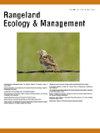西部草地低技术过程修复的成果、实践与规律趋势
IF 2.4
3区 环境科学与生态学
Q2 ECOLOGY
引用次数: 0
摘要
低技术含量的过程修复(LTPBR)越来越多地用于提高河流走廊对土地利用、气候和水资源利用变化带来的各种压力的恢复能力。然而,LTPBR的未来取决于多种物理、生态和社会因素,包括水资源可得性对LTPBR结果的影响,以及在缺水环境中未来恢复的法律能力。越来越多关于LTPBR的科学和法律文献允许对LTPBR项目进行定量的、区域的比较,以了解:(1)LTPBR项目的物理特征(包括结构类型、数量和当地环境)如何影响LTPBR之后的变化幅度?(2)与从业者态度和水法相关的社会维度如何影响LTPBR?我们评估了美国西部65个LTPBR项目的数据,这些项目使用了天然海狸坝、类似海狸坝或单岩坝,以量化通常测量结果与地理位置、项目规模和当地降水的趋势。我们还回顾了美国西部五个州的水法,并采访了13位恢复从业者,以考虑LTPBR的社会维度。结果表明:LTPBR项目显著增加了库水、库沙和河岸植被的绿化率,且这一结果与年平均降水量、恢复时间和LTPBR类型存在显著差异。趋势表明,即使在水资源供应不断变化的情况下,LTPBR也可以在西部牧场提供预期的结果。州级水法的改变和对LTPBR社会效益的认识可以支持在牧场溪流中扩大溪流恢复。为了更好地实施、管理和理解LTPBR项目及其成果,需要更多的监督和协作。本文章由计算机程序翻译,如有差异,请以英文原文为准。
Trends in the Outcomes, Practice, and Law of Low-Tech Process-Based Restoration in Western Rangelands
Low tech process-based restoration (LTPBR) is increasingly used to improve river corridor resilience to diverse stressors introduced by changing land use, climate, and water usage. However, the future of LTPBR depends on multiple physical, ecological, and social factors, including the influence of water availability on LTPBR outcomes and the legal capacity for future restoration in water-limited environments. A growing body of scientific and legal literature on LTPBR allows for a quantitative, regional comparison of LTPBR projects to understand: (1) How do physical characteristics of LTPBR projects (including structure type, number, and local setting) influence the magnitude of change following LTPBR? and (2) How are social dimensions related to practitioner attitudes and water law impacting LTPBR? We evaluated data from 65 LTPBR projects in the western U.S. that used natural beaver dams, beaver dam analogues, or one-rock dams to quantify trends in commonly measured outcomes with geographic location, project size, and local precipitation. We additionally reviewed water law in five states across the western U.S. and interviewed 13 restoration practitioners to consider the social dimensions of LTPBR. Results show that LTPBR projects significantly increased water storage, sediment storage, and riparian vegetation greenness, and that outcomes vary significantly with mean annual precipitation, time since restoration, and LTPBR type. Trends suggest that LTPBR could provide expected outcomes across western rangelands even amid changing water availability. Changes to state-level water laws and perceptions of social benefits of LTPBR could support the expansion of stream restoration in rangeland streams. More monitoring and collaborations are needed to better implement, manage, and understand LTPBR projects and outcomes.
求助全文
通过发布文献求助,成功后即可免费获取论文全文。
去求助
来源期刊

Rangeland Ecology & Management
农林科学-环境科学
CiteScore
4.60
自引率
13.00%
发文量
87
审稿时长
12-24 weeks
期刊介绍:
Rangeland Ecology & Management publishes all topics-including ecology, management, socioeconomic and policy-pertaining to global rangelands. The journal''s mission is to inform academics, ecosystem managers and policy makers of science-based information to promote sound rangeland stewardship. Author submissions are published in five manuscript categories: original research papers, high-profile forum topics, concept syntheses, as well as research and technical notes.
Rangelands represent approximately 50% of the Earth''s land area and provision multiple ecosystem services for large human populations. This expansive and diverse land area functions as coupled human-ecological systems. Knowledge of both social and biophysical system components and their interactions represent the foundation for informed rangeland stewardship. Rangeland Ecology & Management uniquely integrates information from multiple system components to address current and pending challenges confronting global rangelands.
 求助内容:
求助内容: 应助结果提醒方式:
应助结果提醒方式:


